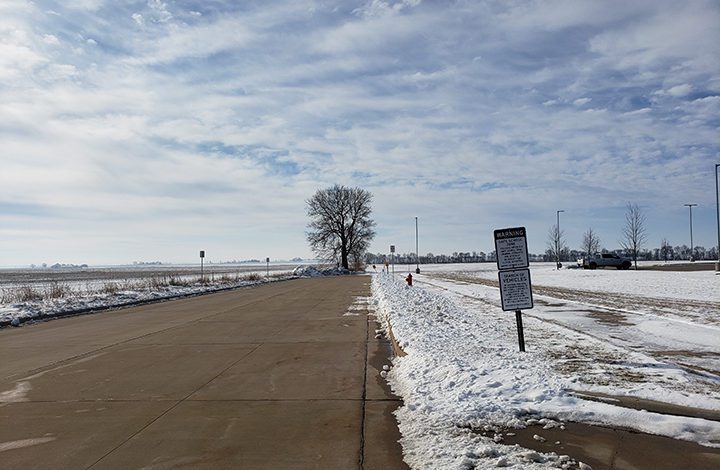Top 10 Things to Know About Current Mahomet Development

Where Mahomet is Now
A 2018 special census by the Village of Mahomet showed that the Village had 8,628 residents within its limits. Those numbers do not reflect unincorporated Mahomet, which the Illinois Demographics projects would make the grand total closer to 14,054 residents. In every decade since 1980, Mahomet has seen a 50-percent population growth.
10) Development Plans That Have Been Approved
Mahomet will continue to see growth over the next decade. The following is an account of land currently being built upon, up for sale or projected to be developed according to developer websites.
| Subdivision Name | Number of Total Lots on Developer Website | Number of lots sold (some have homes, others do not) |
| Sangamon Fields | 266 lots | |
| Solace Apartments | 200 two-to-three bedroom apartments | |
| Harvest Edge (First Phase) | 42 lots | 9 sold |
| Hunters Ridge | 83 lots | 11 sold |
| Ridge Creek | 44 lots | 8 sold |
| Thornewood Fifth | 103 lots | Number of sold unknown, much of the next two phases has not been developed yet |
| Prairie Crossing | 76 lots | 33 sold |
| Jacob’s Landing | 61 lots (in the Mahomet school district) | 31 sold |
| Whisper Meadows (Phase II) | 30 lots | 13 sold |
| Vision South | 19 lots | 10 sold |
The Village of Mahomet Planning and Zoning Commission has been told about other developments, including apartment structures that are expected to be developed in downtown Mahomet and along Prairieview Road, among other locations.
The Mahomet Downtown Master plan includes eight townhome buildings, plus seven 3-to-4 story mixed-use buildings.
According to the U.S. Census Bureau, the average persons per household from 2014-2018 was 2.83. Also, according to AreaVibes.com, 56-percent of homes in Mahomet have children under the age of 18.
9) Room for More Growth
In the 2016 Village of Mahomet Comprehensive Plan, the Village writes, “Over half of the area of the Village is currently used for agriculture or otherwise undeveloped. The eastern edge of the Village includes several hundred acres of agricultural land. Outside the Village boundary, over 80-percent of the 1.5-mile planning area is composed of agricultural uses. Undeveloped areas include parcels with significant topography or natural features, areas formerly mined or used for industry, and lots platted for residential or commercial uses, but not yet developed. There is little scattered parcel vacancy within the developed areas.”
While the Village could grow east toward Champaign, west toward Mansfield, north toward Fisher or South toward Bondville, plans are already coming together for further residential growth on the east side of town.
Village Administrator Patrick Brown is confident that the land surrounding the Mahomet-Seymour School District’s property on the east side of town is ready to develop with some additional tax-funded infrastructure.
Currently, the 77-acres purchased by the district in 2010 is surrounded by residential zoning: Vision South to the northwest, Middletown Place Apartments, which still have vacancies, to the north, and 309 acres of land zoned residential around the east and south of the property.
A map that is included in the September 2019 board packet reveals that some zoning changes may take place in the future to include additional multi-family residential to the north of the school, two-family residential surrounding the school and industrial lining Prairieview Road and IL-150 outside of commercial development at the Prairieview and IL-150 intersection.
8) Extending Churchill
The development hinges on the extension of a TIF district, though.
The Village of Mahomet is in discussions with the Mahomet-Seymour School District to revise an Intergovernmental Agreement that requires the school district to build Secretariat Drive. Secretariat was originally the second access to the development to the west of the district’s property.
The agreement requires: “the District to annually reserve not less than $2,000,000.00 of its authority to issue bonds and borrow funds at all times to cover the financial obligations set forth herein pertaining to the cost of design and construction of the public infrastructure within the Subdivision.”
The Village has asked the school district (and other taxing bodies) to support the extension of a TIF District. Within the support, and should the TIF extension pass through the State legislature, the Village will relieve the school district of its obligation to build a road on the property to fund the project with TIF money.
The extension of Churchill will connect IL-150 with South Mahomet Road. The Village plans to use existing TIF Funds accumulated from previous years to add a railroad crossing from South Mahomet to the proposed Churchill extension.
Originally, South Mahomet Road would follow along the railroad before crossing over to meet up with Prairieview. In the original plan, the Mahomet-Seymour School District’s property would not have roads going through it.
The school board planned it that way.
Then-superintendent Keith Oates told the Village Planning and Zoning Committee that the board wanted a “campus-design” that envisioned a safe landscape for children.
He said the No. 1 concern is the safety in having a main thoroughfare running through the middle of campus. He also said that a continuation of Churchill would divide the district’s 77-acre property, making it less likely to accommodate the district’s desire to place another building on the property.
At the time, the Village of Mahomet voiced concerns about congestion on Churchill and Kassen Drive.
Planning and Zoning Commissioner Nic Glumac voted down the entire preliminary plat.
“Traffic flow and its effects on the community need to be considered quantitatively before site planning, not after,” he said.
Then Trustee — now Mayor — Sean Widener said he would like to see a traffic plan considered during the planning stages. He said it was important to realize the impact the school would have on the surrounding areas.
Village staff and school district officials assured the Village board that traffic flow had been considered, saying that they took proactive steps to ensure traffic flow.
With visible traffic flow issues during drop-off and pick-up times at Middletown Prairie Elementary, the Village believes that a second access point between South Mahomet and IL-150 will relieve congestion.
7) Building and Classroom Space in Mahomet-Seymour
When Middletown Prairie was built in 2015, the Mahomet-Seymour School District tore down the Pre-K/kindergarten building on Division Street, Middletown Elementary. With the MPE renovation and addition for first- and second-grade students in 2017, the district sold Sangamon Elementary for $750,000.
According to Superintendent Lindsey Hall, the Mahomet-Seymour School District is nearly out of classroom space. By her account, Middletown Prairie has three classrooms available, a classroom now being used by reading specialists and two Pre-K classrooms. She also said Lincoln Trail has three available classrooms, but while Mahomet-Seymour Junior High and Mahomet-Seymour High School have been added onto, they have no additional classrooms.
The Mahomet Daily obtained a July 30, 2019 email from former Superintendent Rick Johnston that said the board should consider adding onto Middletown Prairie within the next five years.
“Our projection of a potential addition to the building at the southwest corner for more classrooms within five years may certainly be something to include in your long-range planning,” he wrote.
Hall’s immediate suggestion for fixes included combining some smaller classrooms and having “traveling teachers” in the junior high and high school.
Class sizes at Mahomet-Seymour have been above the state average, and the targeted Evidence-based funding size for a few years.
6) Projected New Buildings
The Mahomet-Seymour School District may have to reconsider plans for the rest of the 77-acres off Churchill Road if a road goes through its property.
Plans for a new building have not been discussed or revealed at a Mahomet-Seymour School Board meeting, but the Village did talk about plans to build a junior high on the school district’s property when it also floated the idea for the Village to purchase the current junior high property, including 13 Acres Park for $750,000.
Some in the community have other ideas, including moving the lower grades to the property so that there is an elementary and secondary campus. The idea would be to keep the elementary students together while adding onto buildings on the west side of town for a secondary campus with athletic fields nearby.
Others have talked about a more immediate fix to the overcrowding situation by building onto Lincoln Trail to bring sixth-grade students there within a couple years while also putting additions onto the high school and Middletown Prairie.
There has also been talk about looking decades down the road; if Mahomet could exponentially grow, and there is no stopping it, should the plan that looks out for decades include additional elementary and junior high schools?
In grades K-5, Mahomet-Seymour has strands of 10-12 grades per building whereas many other districts of Mahomet’s size and beyond, break out into 3-to-4 grade strands per building.
5) The Village Plans for MARCC
The Village would tear down much of the Mahomet-Seymour Junior High building, leaving the athletic facilities and add a public outdoor pool on the property.
The Village expects the MARCC building to cost $10 million. The Village plans to look into private donations, but also said the taxpayers would have to vote for a tax increase to make the building happen.
Widener said if the Village could not move forward with the purchase of the junior high, for whatever reason, it would still retain ownership of 13 Acres Park, but would reimburse the school district for $225,000, although that amount is still under discussion.
Once the new intergovernmental agreement is established, the Village will take possession of 13 Acres immediately. Much like Taylor Field, the Village is looking to make improvements to 13 Acres Park, but cannot do so without ownership of the property.
4) Other Infrastructure
The Village of Mahomet expanded its wastewater treatment facility from 2011 to 2015. The four-year $15 million project was slotted to relieve pressure on the system, which was serving 1,000 residents over what it was designed to do.
The upgrade also allowed for the Village water district to provide nitrate and phosphorous removal.
The expansion allowed the system to serve 9,000 people and Phase II could serve up to 12,500 people. The design is supposed to fulfill the Village needs until 2030.
According to the Mahomet Citizen, the facility served 6,400 people in 2014. Jason Heid, Mahomet’s water and wastewater superintendent said the Village could tell the Daily how many connections there were, but that they were unsure about the number of residents at this time. With a busy morning, the Daily has not heard back from the Village about connections at this time.
He also said that while water and wastewater infrastructure usually rests on the backs of developers in residential areas, the Village is focused on providing infrastructure to commercial entities on the east side of Mahomet.
The Village also looks to replace and upgrade water mains in the older parts of Mahomet.
In 2005, the Village of Mahomet tripled its water treatment capacity, which was projected to serve the community until 2040.
“We’re always looking toward the future and making sure we aren’t doing anything last minute,” Heid said.
Both the Mahomet Water District and Sangamon Valley Public Water District get their water from the Mahomet Aquifer. Heid said the area is blessed with a great water supply while other parts of the nation are struggling with a sustainable water supply.
Sangamon Valley Public Water District upgraded their water treatment facility from 2014 to 2018. The $6.3 million project upgraded the water capacity from 800,000 gallons per day to 1.8 million gallons per day.
3) Commercial Developments
For years, the Village of Mahomet and Mahomet-Seymour School District have had their eyes set on commercial developments to help diversify their tax base.
In 2000, the Village established the East Mahomet TIF District, which was revised in 2009 to capture some of the 100-percent pass through that was going to other taxing districts. For the last decade, the TIF fund has collected 50-percent of commercial property taxes for infrastructure.
In 2019, the Village established a second Commercial Core TIF District that will collect 100-percent of the increase in residential and commercial property values for the next 23 years.
Those funds can be used towards property acquisition, rehabilitation or renovation of existing public or private buildings, construction of public works or improvements, job retraining programs, relocation, financing costs, including interest assistance, studies, surveys and plans, professional services such as architectural, engineering, legal, property marketing and financial planning, demolition and site preparation and day care services to spur commercial growth.
The Village hopes that with the extension of the East Mahomet TIF, it will be able to provide the Churchill Road extension while also getting water and sewer to the south and east of Middletown Prairie.
Brown believes that this will encourage landowners to develop their commercial property.
Already the Village has seen the development of two of the three retail buildings at Churchill Crossing, Vision South has a preliminary plan and Sunset Funeral Home has announced plans for a building on Churchill.
The Village of Mahomet used a State grant to widen IL-150 and TIF money for construction and installation of water and sewer to 975 acres in the East Mahomet TIF District.
Brown said there has been interest in development, especially on the property that is to the south of Farm Credit Illinois, but no one has heard anything in three or four years.
“Stuff like that will come back around,” he said.
He continued on to report that the Village has heard from developers interested in the lots to the south of McDonald’s over the last year.
Brown said that the infrastructure that the Village put in is “on the perimeter” of the property. He also stated that the elevation of the land is a hindrance.
“It is a very costly project for anyone to take on,” he said.
Brown believes that by doing one project at the intersection, it could “open up” four quadrants of land for development.
The TIF extension can only happen when the Illinois State Legislature approves it. The Village is collecting letters of support from all taxing bodies at this point in time.
2) Bonding
In building the $32.7 million Middletown Prairie, the Mahomet-Seymour School District bonded against its annual $2.2 million from the Champaign County one-percent sales tax.
According to the Illinois State Board of Education’s 2019 Financial Report, the Mahomet-Seymour School District had 17.92 percent of its long-term borrowing limit left in 2018.
At the Dec. 2019 Financing Committee meeting Managing Director at Stifel Nicholaus Kevin Heid explained the parameters for borrowing money when building schools.
Per Illinois School Code, schools cannot erect a freestanding building without passing a referendum.
“Even if you’re a wealthy power plant district and have all the money in the world you cannot build the building without a referendum,” Heid said. “Even if you pay cash, you can’t build a building.
You can lease a building, and at the end of the lease term, you can own it.
But school districts can make an addition to a building, issuing bonds, without passing a referendum, like they did with Middletown Prairie Elementary.
Heid said that if Mahomet-Seymour wanted to build a free-standing junior high, the district would have to lease it or they would have to pass a referendum, it has to be a life safety replacement or someone has to give the district money.
“Life safety replacement means it has to be like-use, junior high for junior high, it can be no more square footage than the existing building and the architect has to prove that it costs less to build new than to do all the repairs necessary on the old building,” Heid said.
According to the Feb. 18 board packet for the Mahomet-Seymour School Board, the district has under $200,000 in the Life Safety fund.
Hall said the district cannot borrow over their tax cap. She also stated that if 10-percent of registered voters file a petition they can stop the issuance of cash bonds.
1)The Community Price Tag
“Any substantial building project that we are going to build, whether it’s a high school, junior high or multiple additions at the same time, most probably exceeds what we will be able to do without a tax increase,” McComb said. “Therefore, anything we do is going to be run by the voters.”
McComb said the fact that the Mahomet-Seymour community will have to vote on a tax increase is why they will begin a community engagement process in 2020.
Should the district move out of the junior high, part of the TIF extension understanding will include that the Village will be allowed to purchase the junior high, Middletown Field and 13 Acres for $750,000.
The Village said they are working on funding for that purchase, but to tear down half of the building, turn it into a MARCC Center and build a swimming pool, they would also need additional tax dollars from the taxpayers.
The district and Village said there is not yet a timeline on when they will have to go to the taxpayers.





